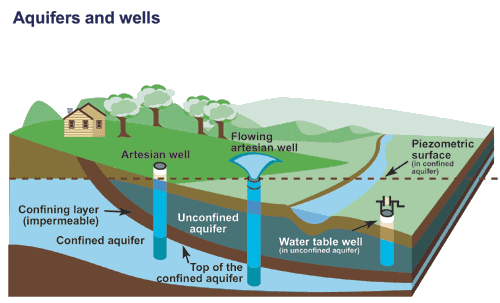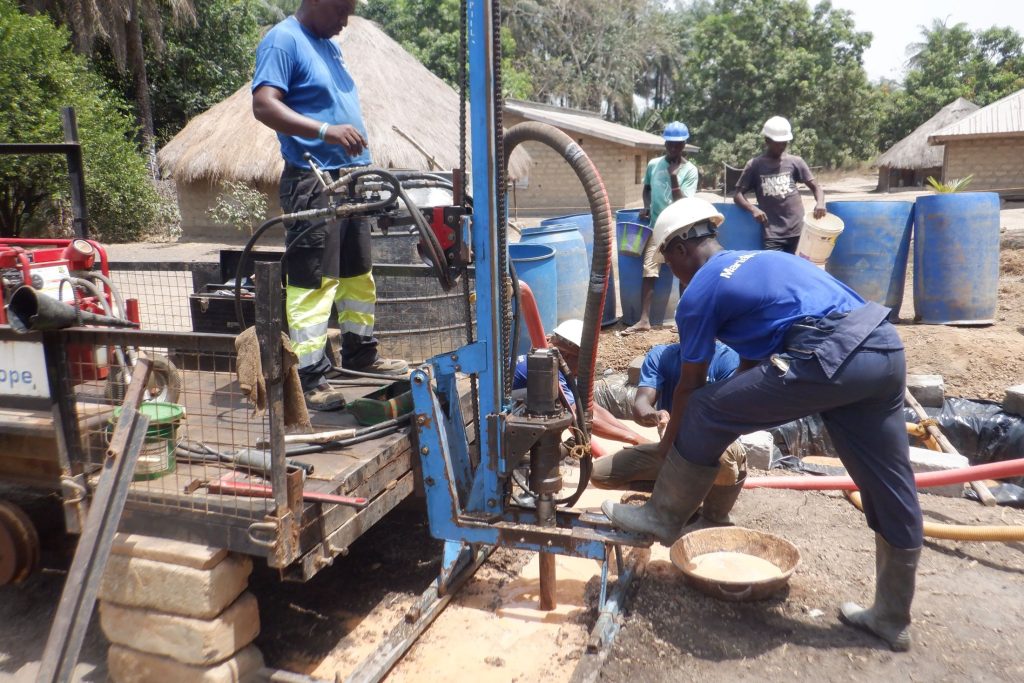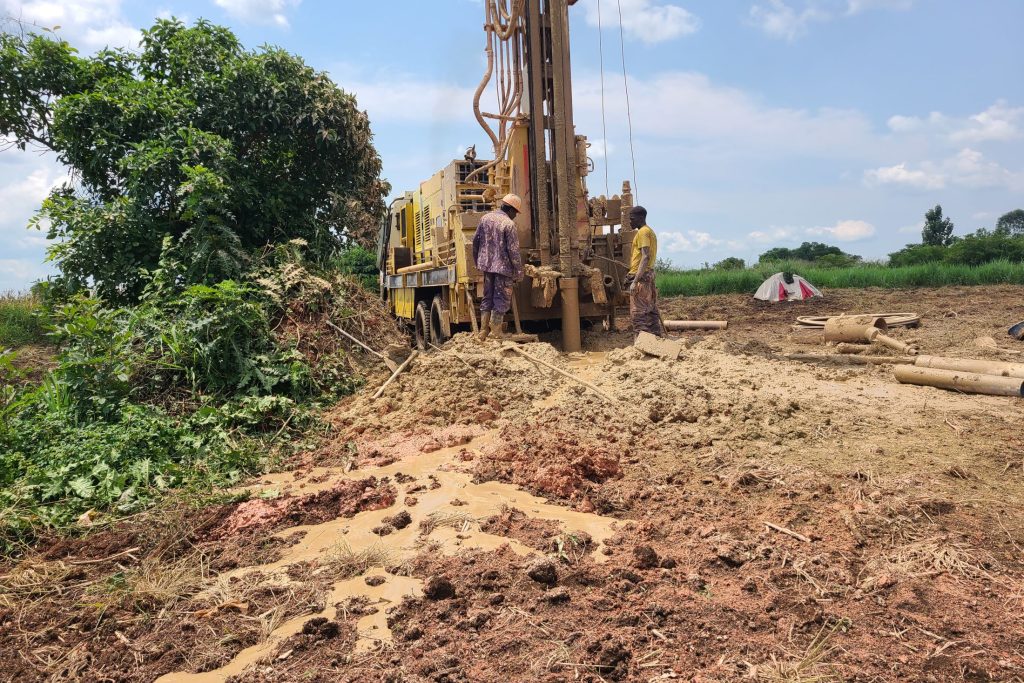Do The Water Project’s Wells Deplete Groundwater Reserves?
When you picture water being drawn up through a borehole well, it might seem like we’re draining a limited supply—like sipping from a giant underground cup that’s slowly running dry.
It’s no wonder we receive this question from time to time — people want to be sure we aren’t stealing from future generations’ water supply by building our water projects.
And it’s a fair concern. Human pollution can have a devastating effect on groundwater (water beneath Earth’s surface). And, if humans drill too many wells in one spot, aquifers can eventually run dry.
But where The Water Project (TWP) works in Sub-Saharan Africa, groundwater remains an underutilized lifeline — one that can be accessed safely, sustainably, and equitably when the right systems are in place. Our team, in partnership with local government and global best practices, has built a deep understanding of how our boreholes interact with aquifers and groundwater levels.
Here’s what we’ve learned.
The Problem
An aquifer is a naturally occurring underground layer of water-bearing rock or sediment.

Aquifers’ water-holding and contamination-protecting properties vary based on their surrounding geology. Some are shallow and vulnerable to contamination. Others are deeper and naturally protected. Some refill relatively quickly. Others “recharge” slowly over time.
“The groundwater boom has also led to serious declines in groundwater levels in some areas, with attendant problems of quality deterioration, environmental degradation, and rising costs as some regions and countries now use more groundwater than is recharged naturally.”
Cobbing, 2019
Because rainfall levels take so long to affect underground aquifers, one drought won’t necessarily harm a community’s underground water resources.
“One of the greatest benefits of groundwater is its resilience to climatic variation. Groundwater is not reliant on the last 1–2 years of rainfall, but integrates rainfall over years and decades.”
UNESCO
But this benefit can become a detriment when times are dire: When we extract too much groundwater, aquifers often take a long time to refill. Hydrogeologists and water resource engineers have developed methods to replicate this recharging process artificially, but adoption of this practice has been slow.
The Untapped Opportunity
Despite dire headlines about global groundwater depletion in much of the world, most of Sub-Saharan Africa isn’t running out of groundwater like other nations that have been extracting high volumes for years.
“Regions heavily reliant on groundwater for irrigation include North America and South Asia, where 59% and 57% of the equipped area use groundwater, respectively, while in Northern Africa it is 35% and in Sub-Saharan Africa only 5%.”
UNESCO
Water sector experts have already mapped Africa’s vast groundwater resources. But unfortunately, the people of sub-Saharan Africa are still struggling to access their groundwater in the first place. The real constraint in many African regions is not water scarcity, but the absence of services and infrastructure: energy, trained personnel, equipment, financing, and institutional support.
At The Water Project, we’ve seen this firsthand. Water stress in the areas we serve is often the result of poverty, not hydrology.
Poverty Limits Water Access—Not the Aquifer
In these regions, a lack of water access doesn’t mean a lack of groundwater. It means there aren’t enough resources to tap into it safely and reliably.
“At first glance, drilling and handpump technology does not appear to be incredibly complicated. However, the combination of technical, social, and institutional dimensions means that the provision of a sustainable groundwater resource is actually quite complex. ”
Rural Water Supply Network
Think of it like this: the aquifer is the pantry. But the community doesn’t have a key to open the door. Or worse — maybe they do have a key, but it’s rusty, and the lock is broken. That’s what it’s like relying on a contaminated spring or an unprotected well.
“In many Sub-Saharan countries, the water resources department of government is chronically underfunded, under-skilled and often ignored even when major problems are identified.”
Rural Water Supply Network
That’s where The Water Project comes in. With a properly sited, drilled, and maintained borehole, that deep groundwater becomes accessible to the whole community — without overdrawing the supply.
Not All Aquifers Are the Same
Even with so much groundwater just lying in wait for human use, being mindful of where and when we drill wells is still crucial. After all, there is much we can learn from previous generations’ mistakes in other parts of the world.
This is why we never drill a well blindly.
Before siting a borehole, we conduct hydrogeological surveys to understand the local geology, aquifer depth, and recharge conditions. We only proceed when groundwater access is both viable and sustainable. If it’s not, we don’t drill.

In our Western Kenya service area, the government requires that all planned borehole wells have an environmental impact report and hydrogeological survey conducted by an accredited hydrogeologist. Because the site has to be pre-approved by the government before drilling begins, this process often begins months before the drilling. The Water Project is fortunate to have an accredited hydrogeologist on staff in Western Kenya, who coordinates with the government and guides us in our effort to access precious groundwater resources responsibly.
In Uganda, we conduct hydrogeological surveys at the time of drilling. The drillers conduct the survey and use it as a tool for borehole well siting, ensuring that groundwater is available before the drilling process begins.
In Sierra Leone, our local team uses its own equipment for the surveys in order to reduce the frequency of failed drills in this region. Though the government does not require pre-approval of hydrogeological surveys, the Port Loko District is a geologically complex area that can be tricky for drilling, and a positive result from the hydrogeological survey improves the likelihood of success.
In every case, local geology matters.
Residential Boreholes Don’t Have the Yield to Drain Aquifers
Globally, 69% of groundwater is used for agriculture, 22% for domestic use, and 9% for industry. The small-scale withdrawals from TWP-supported schools, healthcare facilities, and households are minimal by comparison.
A single community borehole typically serves a few hundred people, each drawing just a few liters per person per day. Compared to large-scale agricultural or industrial pumping, the water drawn from community boreholes is minimal.

In fact, our team has examined this concern in detail and concluded that individual boreholes — especially those informed by hydrogeological surveys and monitored over time — do not pose a risk of depleting their aquifers. The maximum yield of most boreholes in our programs is simply too small to create a significant regional drawdown.
“An individual handpump is very unlikely to deplete an aquifer because the abstraction rate is so low compared to the replenishment of the resource by the average annual recharge. However, the combined effects of dozens, or hundreds of pumps at times of water stress (e.g. at the end of the dry season) may cause problems.”
Rural Water Supply Network
That means our water points, while carefully managed, do not significantly strain the aquifers from which they draw. But that doesn’t mean it will always stay that way, which is why we continue to monitor groundwater levels throughout the regions we serve.
For example: The Water Project worked with researchers to simulate the impact of new wells in Kenya’s Kakamega and Vihiga counties, where many of our projects are located. Using a groundwater modeling tool called MODFLOW, they input real-world data like rainfall, soil type, aquifer depth, and river locations to test how new boreholes might affect groundwater levels.
The result? Even when the model assumed a full-size community well, most sites showed little to no long-term drawdown. In fact, the modeling process helped identify which areas were best suited for new wells — and flagged a few spots that might be more sensitive, so we could avoid them.
This modeling gives us confidence that our boreholes won’t deplete the aquifers. It also gives us a powerful tool for future planning, especially as more communities request access to safe water.
We design our projects with sustainability at their core.
Monitoring Ensures We Catch Problems Early
Borehole viability isn’t a “set it and forget it” situation. Every borehole installed through The Water Project is added to our ongoing Water Promise maintenance program.
Through this system, our monitoring and maintenance team members routinely track the following components of borehole wells:
- Pump usage and functionality
- Static water level (the depth of a well’s water table before pumping begins)
- Signs of aquifer stress
- Community feedback and usage patterns
This data helps us identify issues early and ensures a project’s long-term sustainability. If a borehole starts underperforming or its water yields decrease, we can investigate and respond quickly.
A Safety Net for Shared Water Tables
In some areas, multiple water points may draw from the same aquifer. We’ve seen this especially in Western Kenya, where boreholes, protected springs, and shallow wells may share a groundwater source.
“Groundwater is an incredible gift of natural water supply infrastructure. However, unlike a man-made water supply network, an aquifer is not designed with the human end-user in mind and it doesn’t exist in isolation. There are linkages between groundwater, rivers, lakes and wetlands. Therefore, whatever is taken for human use may have an ecological impact nearby. Understanding the cause-and-effect relationships requires detailed, long term data collection and study.”
Rural Water Supply Network
To prevent overlap and oversaturation, our teams:
- Use hydrogeological maps and our water point monitoring software’s vetting tools
- Engage government water officials and community water management groups
- Check for nearby water points before drilling
We designed these checks to avoid clustering water points and to protect the integrity of aquifers as a shared resource.
More Boreholes, More Spread-Out Water Access
In fact, when boreholes are thoughtfully sited and maintained, adding more water points can actually reduce pressure on any single source — helping preserve access to groundwater over the long term.
In some regions where aquifer depletion is a problem, demand is concentrated at a handful of old water points. Too many people drawing from one source can stress it — not always because of overpumping, but sometimes because of poor design or lack of maintenance.

Spreading out water use by installing multiple properly functioning boreholes — each monitored, maintained, and built to match the local hydrogeology — relieves pressure on any one source. This reduces the risk of mechanical failure, improves water access, and preserves groundwater in the long run.
TWP is working on long-term groundwater sustainability efforts, both by publishing papers to raise awareness on the issue and by sharing our basic water point data through our water point monitoring software, mWater, for other entities to use.
So… Do TWP’s Wells Deplete Groundwater Reserves?
No, because we do them right.
Borehole wells aren’t a silver bullet. But when they’re thoughtfully sited, responsibly drilled, and monitored over time, they’re one of the most powerful tools we have to create safe, reliable water access in sub-Saharan Africa.
In our work areas, we’re not running out of groundwater. We’re running out of time — time to turn underground potential into real-world impact. Time to reach every last household still walking and waiting for water. And time to meet the UN’s goal of universal access to safe water by 2030.
That’s the work we’re committed to every day. And every borehole well we build — and even every well we don’t build when conditions aren’t right — is part of a bigger promise: to protect this precious resource while unlocking it for the people who need it most. And to keep that water flowing.
Want to be part of that promise? Support sustainable water access today.
Home More Like ThisTweet